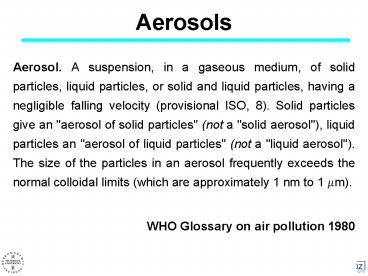Aerosols PowerPoint PPT Presentation
1 / 20
Title: Aerosols
1
Aerosols
- Aerosol. A suspension, in a gaseous medium, of
solid particles, liquid particles, or solid and
liquid particles, having a negligible falling
velocity (provisional ISO, 8). Solid particles
give an "aerosol of solid particles" (not a
"solid aerosol"), liquid particles an "aerosol of
liquid particles" (not a "liquid aerosol"). The
size of the particles in an aerosol frequently
exceeds the normal colloidal limits (which are
approximately 1 nm to 1 ?m). - WHO Glossary on air pollution 1980
2
Aerosols
- References
- Graedel TE, Crutzen PJ (1994) Chemie der
Atmosphäre Chapter 8 172179 - Jacob DJ (1999) Introduction to atmospheric
chemistry Chapter 8 144154 - Seinfeld JH, Pandis SN (1998) Atmospheric
chemistry and physics Chapter 79 408544
3
Production, growth, and removal of atmospheric
aerosols
Jacob 1999 fig. 8.2
4
Schematic chemical aerosol cycle
from Graedel Crutzn 1994 fig. 8.11
5
Size distribution of atmospheric aerosols
after Whitby Sverdrup 1980
6
Average volume size distribution of continental
aerosols
from Warneck 1988
1) Background aerosol 2) normal background
aerosol 3) background disturbed by urban plume
4) average urban aerosol dashed curve rural
continental aerosol (smoothed idealised
log-normal display)
7
Size distribution of different aerosols
- urban
- rural continental
- marine
- sea salt
from Warneck 1988
fining up sequence of aerosols from marine via
rural to urban
8
Residence times of particles in the troposphere
from Jaenicke 1978
9
Vertical distribution of aerosols
from Jaenicke 1993, in Seinfeld Pandis 1998
fig. 7.25
Hp scale height (marine 900 m remote
continental 730 m desert 2000 m polar
aerosol 30,000 m) below Hp exp, above Hp
constant
10
Size distribution of aerosol species
from Wall et al. 1988 in Seinfeld Pandis 1998
fig. 7.23
11
Typical composition of fine continental aerosol
Heintzenberg 1989 in Jacob 1999 fig. 8.1
12
Aerosol sampling
Partisol Model 2300Speciation Sampler
Rupprecht Patashnick Co., Inc.
13
Inlet/Denuder Section ChemComb Speciation
Cartridge Partisol Model 2300 Speciation Sampler
Aerosol sampling
- PTFE coated inlet and PM-2.5 keyhole impactor (at
right) inlet minimizes sample residence time and
surface contact - Glass standoff, two glass honeycomb denuders,
spacers and a tension spring make up the denuder
section the denuder section may be empty if no
gas collection or stripping is desired, or may
contain one or two denuders
14
Erzgebirge aerosol in comparison
15
Radiative effects of aerosols
Scattering the scattering efficiency is the
probability that a photon incident on the
particle will be scattered. Atmospheric aerosols
in the accumulation range are efficient
scatterers of solar radiation because their size
is in the same order of magnitude as the
radiation wavelength Visibility
reduction atmospheric visibility is defined by
the ability of our eyes to distinguish an object
from the surrounding background. Scattering of
solar radiation by aerosols is the main factor
limiting visibility in the troposphere. In the
absence of aerosols, our visual range would be
ca. 300 km, limited by scattering by air
molecules. Pertubation to climate Scattering of
solar radiation by aerosols increases Earths
albedo because a fraction of the scattered light
is reflected by to space. The result is cooling.
Problem anthropogenic aerosols vs. natural
aerosols, e.g. from volcanic eruptions
after Jacob 1999
16
Radiation scattering by aerosols
A
B
from Jacob 1999 figs. 8.3, 8.4
D
C
- Beam scattering
- reflection
- refraction
- refraction and internal reflection
- diffraction
Scattering efficiency of green light (l 0.5
µm) by a liquid water sphere
17
Visibility reduction
from Jacob 1999 fig. 8.5
The visibility of an object is determined by its
contrast with the background (2 vs. 3). This
contrast is reduced by aerosol scattering into
the line of sight (1) and by scattering of
radiation from the object out of the line of
sight (3)
18
Earth mean T and Mt. Pinatubo eruption 91
from Jacob 1999 fig. 8.6
The Pinatubo eruption in September 1991 was
followed by a noticeable decrease in global mean
temperatures for the subsequent 2 years because
of the long residence time of aerosols in the
stratosphere
19
Simple model to predict aerosol T forcing
DF radiative forcing trend, DA albedo change
FS solar radiation flux
from Jacob 1999 fig. 8.7
FS solar radiation flux Ft flux transmitted
through the aerosol layer Fd flux scattered
forward (down) Fu flux scattered backwards (up)
20
Global averaged radiative forcing as of 1850
from IPCC 1995

